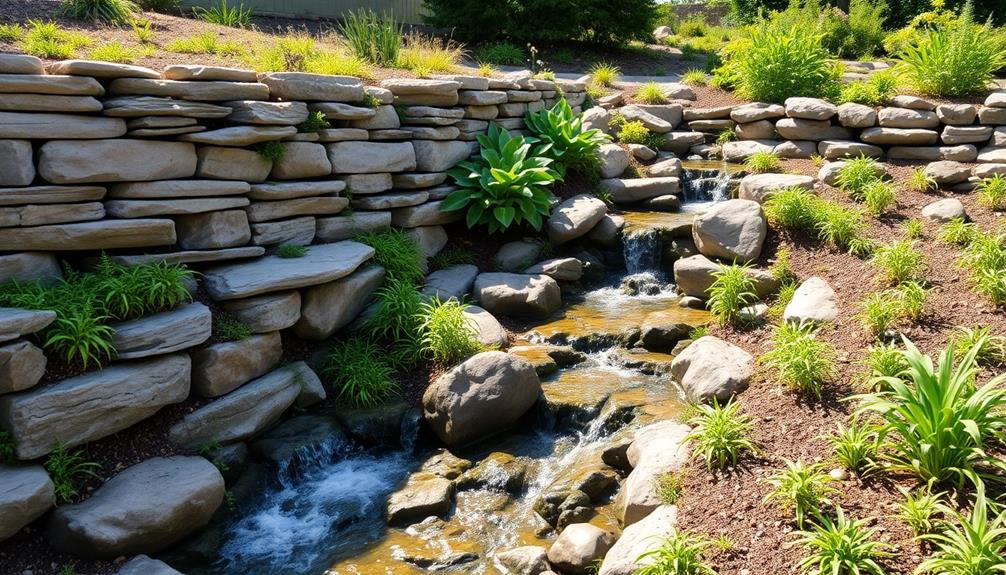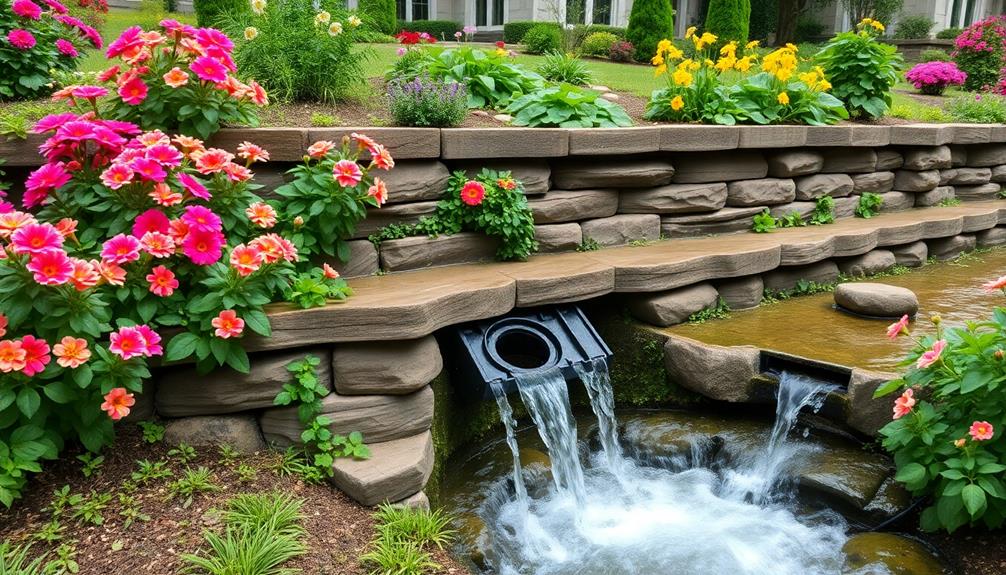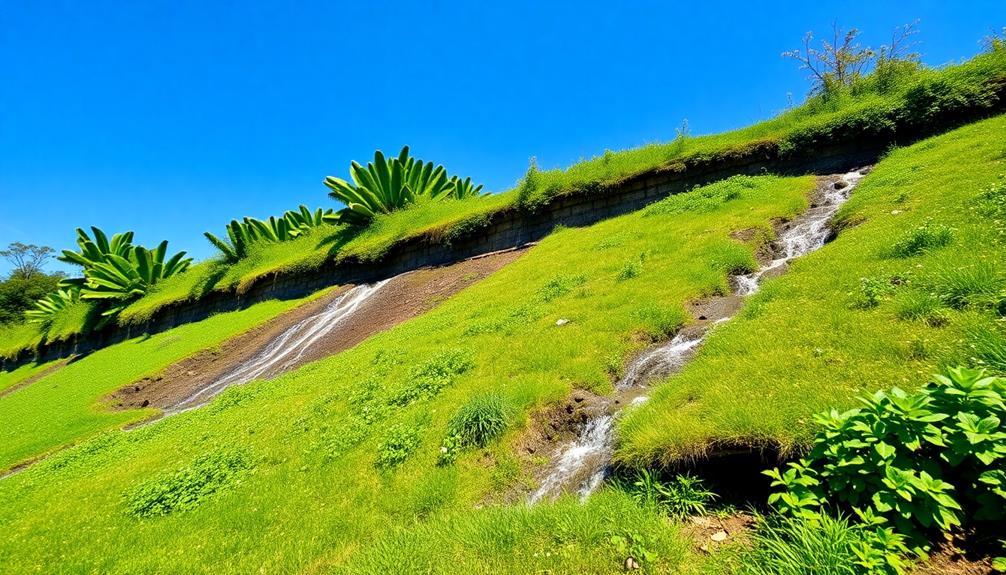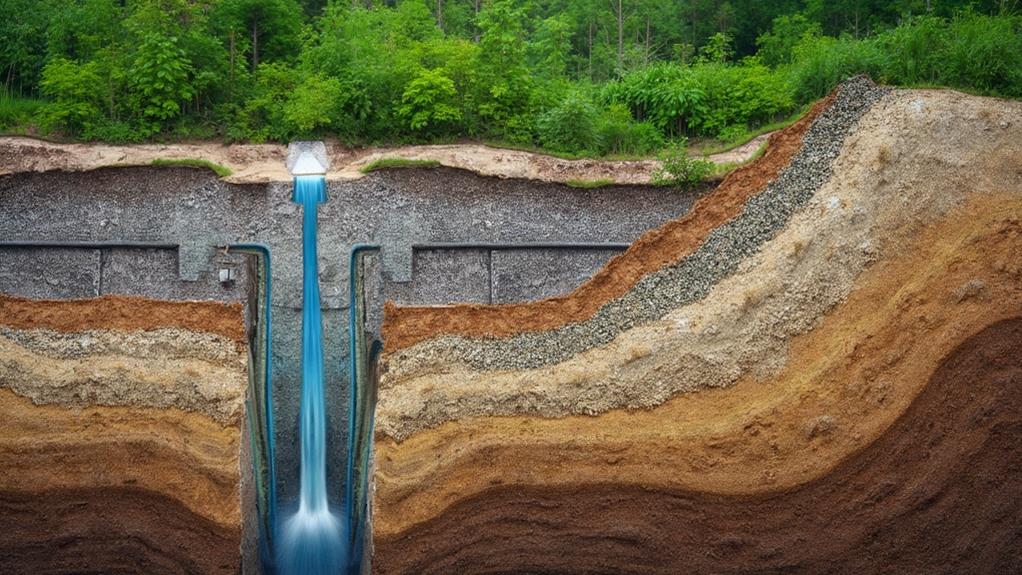Proper drainage is indispensable for retaining walls as it channels water away, reducing hydrostatic pressure that can compromise structural integrity. By incorporating elements such as perforated pipes, gravel backfill, and geotextile fabrics, drainage systems prevent water accumulation and soil saturation, which can lead to erosion and material degradation. This controlled water flow not only enhances the stability and longevity of retaining walls but also aligns with building standards, ensuring safety and reducing maintenance costs. With a detailed understanding of drainage components, one can better appreciate its essential role in maintaining the function and aesthetics of retaining walls.
Table of Contents
ToggleWalls Contractor Highlights
- Proper drainage prevents hydrostatic pressure build-up against retaining walls.
- It enhances the structural stability and longevity of retaining wall systems.
- A well-designed drainage system minimizes soil erosion at the wall's base.
- Proper drainage reduces maintenance costs by preserving wall materials.
- It channels water effectively away from the wall to prevent damage and soil saturation.
Definition of Proper Drainage

Proper drainage is a vital element in retaining wall design, guiding water flow away from the structure to mitigate the risk of hydraulic pressure buildup, which can severely compromise the wall's integrity. Applying these methods guarantees that soil stays in place, thereby preventing issues such as erosion.
Retaining walls, from those made with durable boulder options to the elegant limestone varieties, benefit tremendously from efficient drainage systems. By incorporating essential components such as perforated pipes, gravel backfill, and weep holes, a well-planned drainage system effectively channels water, reducing the potential for erosion and structural damage.
Understanding these components and their role in maintaining water management ensures long-lasting stability and performance of retaining walls.
Importance of Water Flow
Guaranteeing effective water flow is integral to maintaining the structural integrity and longevity of retaining walls. Proper drainage is not simply an ancillary feature, but a necessity that secures water does not build up behind the wall, which could led to increased pressure and eventual failure.
Recognizing the importance of water dynamics can foster a sense of shared responsibility and community among those engaged in property maintenance or landscaping, as they aim collectively towards sustainable and resilient designs.
To underscore the necessity of managing water flow, consider the following:
- Pressure Mitigation: Controlled water flow reduces hydrostatic pressure, which is the force exerted by water against the wall. This pressure can be detrimental if not appropriately managed.
- Erosion Prevention: By guiding water away efficiently, the potential for soil erosion at the base of the wall is minimized, leading to increased stability and reduced maintenance requirements.
- Material Longevity: Water exposure can rapidly deteriorate wall materials. Adequate drainage preserves material integrity, offering prolonged service life and value.
Implementing these principles not only fortifies the physical structure but also engenders a sense of pride and stewardship within the community, as members work towards achieving an enduring and aesthetically pleasing landscape.
Preventing Structural Damage
Understanding the dynamics of water flow sets the stage for implementing strategies to prevent structural damage to retaining walls. When water is left unmanaged, it can exert excessive lateral pressure against these barriers, leading to cracks, bulging, or even catastrophic failure. Proper drainage is a pivotal component in mitigating such threats, ensuring that water does not accumulate and compromise the integrity of the wall's construction.
By channeling water away from the wall, effective drainage precludes the saturation of soil behind it, which can expand and exert force on the retaining structure. This process typically relies on a gradient that permits gravity to naturally redirect water, in conjunction with materials that facilitate unobstructed flow. Additionally, the type of soil and its permeability significantly influence how water interacts with the retaining wall, further underscoring the necessity for tailored drainage solutions that account for these variables.
For those invested in the durability and stability of retaining walls, embracing inclusive drainage strategies forms a shared understanding of preventative care. By adhering to these principles, community members can safeguard their investments, fostering environments that are both secure and resilient in the face of environmental stresses.
Drainage System Components
A well-designed drainage system is essential for maintaining the integrity of retaining walls, preventing the detrimental effects of water accumulation. Proper drainage ensures that the structure can withstand soil pressure and environmental conditions without succumbing to the destructive forces of erosion and hydrostatic pressure. To achieve this, certain key components must be incorporated into the system.
- Drainage Pipes: Perforated or slotted pipes are installed at the base of the retaining wall to collect and divert water away, consequently reducing water pressure against the wall. This helps in maintaining the wall's structural stability.
- Filter Fabric: A geotextile filter fabric is indispensable in encasing the drainage pipes, preventing soil particles from clogging the system while allowing water to flow unimpeded. This component is pivotal for long-term system efficiency.
- Gravel Backfill: A layer of coarse gravel is placed behind the wall, promoting drainage by allowing water to flow through the soil more efficiently. This reduces the hydrostatic pressure exerted on the wall.
These components work synergistically to create a robust drainage system, defending the community's structures and spaces they cherish, enabling them to thrive together unimpeded by natural adversities.
Benefits

Implementing effective drainage systems for retaining walls offers a multitude of advantages that profoundly contribute to the wall's longevity and performance. By preventing water accumulation, these systems not only enhance the structural stability of the wall but also extend its lifespan, thereby reducing the frequency and costs associated with maintenance.
This is particularly important for retaining walls that are required to meet building code requirements and structural integrity standards set by licensed and insured companies like Granite Company. Consequently, investing in proper drainage infrastructure becomes an indispensable aspect of retaining wall design and construction, providing both immediate and long-term benefits.
Prevents Water Accumulation
Effective drainage systems for retaining walls play an essential role in preventing water accumulation, which can compromise the structural integrity and longevity of these constructions. Retaining walls without adequate drainage are subjected to hydrodynamic forces that exacerbate wear and tear, leading to potential failures. Proper drainage guarantees that water, whether from precipitation or groundwater, does not linger in close proximity to the wall material, thereby safeguarding it from erosion or the undue stress caused by hydraulic pressures.
In the sphere of construction, preventing water accumulation offers pivotal advantages:
- Mitigation of Hydrostatic Pressure: Proper drainage alleviates the build-up of water pressure behind a retaining wall, a leading cause of structural collapse that must be vigilantly managed to safeguard the safety and durability of the wall.
- Prevention of Material Degradation: Waterlogged conditions contribute to the deterioration of materials such as concrete or wood, accelerating their natural decay and effectively shortening the lifespan of the retaining structure.
- Reduction of Environmental Impact: By effectively channeling water away, drainage systems help avoid waterlogging in surrounding areas, thus preserving nearby ecosystems and maintaining the aesthetic and functional integrity of your community's landscape.
Integration of a robust drainage system fosters confidence and a sense of security within the community, promoting cohesion through shared safety.
Enhances Structural Stability
Robustness in retaining wall design considerably relies on advanced drainage systems to enhance structural stability, ensuring that these critical constructions can withstand various environmental pressures. Proper drainage alleviates the load and stress exerted on retaining walls by directing water away from the structure, mitigating risks of hydrostatic pressure build-up. This pressure, if unchecked, can lead to surface and structural instability, threatening not only the effectiveness of the wall but also the safety of the surrounding landscapes and structures.
Effective drainage systems include elements such as weep holes, drainage pipes, and backfill material that collectively manage water flow. These components work together harmoniously, ensuring that the wall remains steadfast despite the challenges posed by heavy rainfall or melting snow. Moreover, by preventing excessive water absorption and soil expansion, proper drainage safeguards against shifting or tilting, which are common concerns for retaining wall integrity.
Extends Wall Lifespan
A thorough drainage system is pivotal in prolonging the lifespan of retaining walls. Proper drainage facilitates the efficient removal of groundwater, thereby alleviating pressure exerted against the structure. This reduction in hydrostatic pressure is a vital factor that aids in mitigating potential structural failures, such as wall bowing or cracking, which could otherwise shorten the wall's effective life. Implementing a strategic drainage solution not only enhances the wall's durability but also reinforces the community's sense of permanence and resilience.
To further elucidate the benefits of proper drainage on extending a retaining wall's lifespan, consider the following advantages:
- Erosion Prevention: Effective drainage systems minimize soil erosion, preserving the integrity of the soil anchoring the wall and preventing undermining, which could lead to premature structural instability.
- Material Longevity: By maintaining a dry environment, drainage systems protect materials from moisture-related deterioration, such as rust in metal components or freezing and thawing cycles in concrete, thereby extending their working life.
- Foundation Stability: Excess water removal guarantees the foundational soil remains compact, countering soil movement that could otherwise compromise the wall's foundational stability and longevity.
These benefits collectively highlight the indispensable role of proper drainage in ensuring retaining walls stand strong and maintain their functional integrity over time.
Reduces Maintenance Costs
Implementing an adequate drainage system drastically curtails maintenance costs associated with retaining walls. Proper drainage mitigates the risk of water accumulation, which is a primary culprit in deteriorating structural integrity. Without effective drainage, water pressure increases behind the wall, leading to potential damage such as cracking, bulging, or catastrophic failure. These issues necessitate frequent repairs and inspections, which accumulate substantial costs over time.
A well-designed drainage system guarantees that water is directed away from the retaining wall, thereby preserving its structural soundness and minimizing the frequency and extent of maintenance endeavors. By investing in a proper drainage solution, property owners not only shield themselves from the recurring expenses of fixing water-induced impairments but also foster a sense of security and connectedness within their communities. This connection emerges from shared spaces that remain safe and aesthetically pleasing, reinforcing the collective pride in their environment.
Moreover, by reducing the financial burden of ongoing maintenance, stakeholders can allocate resources to other essential community projects, enhancing the overall quality of life. Such prudent investment in drainage systems substantiates a commitment to sustainability and economic efficiency, benefiting both individual proprietors and the broader community.
Soil Erosion Prevention Techniques

To effectively mitigate soil erosion around retaining walls, one must consider a combination of techniques that fortify the structural integrity of the site; these include the strategic implementation of vegetation barriers, the addition of gravel layers for enhanced stability, and the application of geotextile fabrics for filtration and separation. Each technique offers distinct benefits, which can be summarized in the following table:
| Technique | Functionality | Benefits |
|---|---|---|
| Vegetation Barrier | Roots stabilize soil | Natural erosion control |
| Gravel Layer Addition | Improves drainage and soil structure | Reduces waterlogging and compaction |
| Geotextile Fabric Use | Separates soil layers and filters water | Prevents mixing and prolongs wall lifespan |
These methods, when employed together, establish a robust defense against erosive forces, ensuring the long-term efficacy of retaining walls within varied environmental conditions.
Vegetation Barrier Implementation
While the stability of retaining walls is essential for effective drainage systems, incorporating vegetation barriers provides an additional layer of soil erosion prevention. Vegetation plays a pivotal role in reinforcing soil, thus enhancing the structural integrity of these walls.
Beyond aesthetic appeal, plants serve functional purposes such as reducing surface runoff by absorbing water and binding the soil with their root systems.
- Root Reinforcement: The roots of well-selected vegetation penetrate deep into the soil, forming an intricate network that holds soil particles together, thereby stabilizing the slope and reducing erosion risks.
- Water Absorption: Vegetation absorbs excess water from rain or irrigation, decreasing water pressure behind the retaining wall and promoting efficient drainage. This natural absorption helps in minimizing potential water damage to the wall.
- Surface Protection: Ground cover plants act as a protective layer against harsh weather conditions such as heavy rainfall, which can otherwise dislodge soil particles and lead to erosion.
Gravel Layer Addition
In addition to utilizing vegetation barriers for erosion prevention, implementing a gravel layer is another effective technique to safeguard retaining walls. This method provides a dual benefit of enhancing drainage while simultaneously reducing soil erosion. When rainwater flows through the spaces between gravel pieces, it is diverted away from the vulnerable soil, reducing hydrostatic pressure and minimizing the likelihood of erosion. By manipulating the flow of excess water in this manner, gravel plays a pivotal role in maintaining the structural integrity of retaining walls.
The installation of a gravel layer involves strategically placing gravel of uniform size behind the retaining wall. This layer should be adequately thick to support effective drainage and soil stabilization. As a member of our community committed to sustainable architectural practices, understanding these methods can empower you to take control of your property's longevity. Gravel not only supports erosive soil by maintaining its position but also enhances the aesthetic appeal of the landscape, creating a serene and well-managed environment.
Thus, integrating a gravel layer is an indispensable component of an all-encompassing erosion prevention strategy. It reflects a commitment to sustainable and resilient construction practices, ensuring retaining walls stand as enduring fixtures in your environment.
Geotextile Fabric Use
Geotextile fabric serves as a critical component in soil erosion prevention for retaining walls. This engineered fabric aids in maintaining the integrity of the soil by performing several essential functions, creating a cohesive environment where the structural and community needs align. Its strategic employment helps bolster the stability of a retaining wall system, providing peace of mind to those relying on these structures.
This is accomplished through the following mechanisms:
- Separation: Geotextile fabric acts as a separator between different types of soil and the drainage layer, ensuring that each performs its intended function without interference, thus enhancing the wall's durability and utility.
- Reinforcement: By reinforcing the soil, the fabric boosts the structural capacity of the retaining wall, allowing it to withstand environmental pressures and maintain its purpose over time, creating a dependable solution for erosion control.
- Filtration: The permeable nature of geotextile fabric permits water to pass through while preventing soil particle migration. This dual action minimizes sediment build-up behind the wall, reducing hydraulic pressure and mitigating potential damage.
The adoption of geotextile fabric in retaining wall design reflects a commitment to engineering solutions that harmonize with the landscape while ensuring community safety and satisfaction.
Walls Contractor FAQ
What Are the Signs That My Retaining Wall Has Poor Drainage?
Indicators of inadequate drainage in retaining walls include waterlogged soil, visible efflorescence, soil erosion at the base, leaning or bulging sections, and the appearance of cracks. Addressing these issues fosters structural integrity and community safety.
How Can Poor Drainage Affect the Lifespan of a Retaining Wall?
Poor drainage can considerably reduce a retaining wall's lifespan by causing soil erosion, hydrostatic pressure buildup, and structural instability. Addressing drainage issues encourages long-term durability, fostering a sense of security and belonging in well-maintained landscapes and infrastructure.
Are There Specific Materials Recommended for Improving Drainage in Retaining Walls?
For ideal drainage in retaining walls, experts recommend materials like gravel, geotextile fabric, and perforated pipes. These materials collectively enhance water flow, reduce hydrostatic pressure, and protect the structural integrity, ensuring the wall's longevity and reliability.
Can Improper Drainage Impact the Surrounding Landscaping and Environment?
Improper drainage can greatly disrupt surrounding landscaping, leading to soil erosion, plant damage, and destabilized ground conditions. A well-designed drainage system fosters a sustainable and harmonious environment, encouraging community gardens and landscapes to flourish together cohesively.
How Often Should I Inspect the Drainage System of My Retaining Wall?
Regular inspections, ideally semi-annually, maintain your retaining wall's drainage system operates at maximum efficiency. This proactive approach fosters community safety and environmental stewardship, preventing issues that may compromise your shared spaces and contribute to a sustainable landscape.







